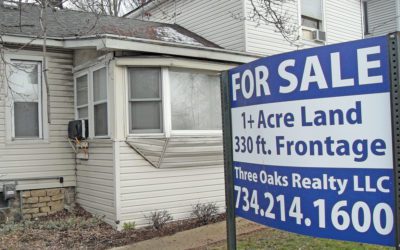
The Fourth Michigan regiment was organized in response to a call by President Lincoln. Ann Arborite George Mogk (seated at right) survived a notorious Confederate prison. | Photo courtesy of Dave McCormick
In December 1862, Confederate General Robert E. Lee’s 78,000-strong Army of Northern Virginia was nestled in the heights behind Fredericksburg, Virginia, awaiting the Federals’ onslaught. Across the Rappahannock River, Major General Ambrose Burnside’s Army of the Potomac held the advantage in numbers—123,000—but that advantage would soon wane.
Among the Union troops were William Boston of Ann Arbor and his half-brother John Sutton of Grass Lake. When they crossed the river to assault Lee’s positions, Boston would fight in Company H of the Twentieth Michigan Infantry, led by graduates of the University of Michigan. Sutton was with Company F of the First Michigan Regiment.
The Civil War began on April 12, 1861, when Confederate artillery opened fire on the federal Fort Sumter, South Carolina. Three days later, University of Michigan president Henry Tappan and other dignitaries in Ann Arbor addressed a public meeting at on the courthouse square at Main and Huron. “The meeting overflowed across the square into the street,” reports a city historic marker on the courthouse wall. “Resolutions were passed supporting President Lincoln and establishing a committee to assist in organizing military companies.
“Four Ann Arbor military units were quickly formed. The ‘Silver Greys,’ a Home Guard unit made up of men over age forty-five, included Tappan and the town’s most illustrious citizens.”
Though the Silver Greys drilled monthly, they were never called on to defend Ann Arbor. But on the day that Ann Arborites gathered at the courthouse, Lincoln issued his first call for volunteers. Before Lee’s surrender four years later, more than 2.6 million men enlisted in the Union army. According to a resource guide in the U-M Bentley Historical Library, more than 90,000 of them came from Michigan; of those, 85,000 were volunteers.
According to the Bentley guide, “At the University of Michigan student companies were organized and formed a university battalion in which nearly every student was enrolled. They drilled well into 1862 and then enlisted in regiments in every part of the Union.” Among the U-M’s 1861 graduates, the Literary Class gave thirty-two out of sixty-two of its members to immediate service, the Medical Class thirty out of forty-four, and the Law Class, twenty out of forty-six.
One of the first city residents to enlist was George Mogk: He joined Company E, First Michigan Infantry, with the rank of first lieutenant on April 24. Those first enlistments were for just three months, so on August 7, he mustered out only to enlist in Company K ten days later. On July 5, 1862, he was reassigned to Company G.
In August 1862, Mogk was captured at the Second Battle of Bull Run. He was confined to Libby Prison in Richmond, Virginia, notorious for its inadequate rations, open privies, and virulent diseases. Unlike many other Union captives, he survived to be mustered out a second time in September 1864.
Related: The Signal of Liberty
The Twentieth Michigan Infantry, where Boston served, was formed in July 1862 in response to another call for recruits. There’s a metal reproduction of a recruiting poster on a planter alongside the courthouse; it offered a cash bounty and warned of a draft if the response fell short.
The Twentieth was among the forces rushed to Maryland in September when Lee’s army invaded the state. The advance was blunted at the Battle of Antietam, but Lee escaped with most of his troops to await the Union’s counterattack.
That came in December, at Fredericksburg. Federal commander Ambrose Burnside hoped to make a surprise crossing into Virginia, but delays allowed Lee to gather his forces and fortify positions outside the town. And so separately, the half-brothers found themselves amongst the shell and shot that rent the air below Marye’s Heights on December 13.
Confederate General James Longstreet’s forces commanded an uninterrupted field of fire a half mile in length. One of his artillery officers remarked, “A chicken could not live on that field when we open [fire] on it.” As Burnside ordered the mass of blue uniforms to march forward in one wave after another, it quickly became a bloodbath.
Boston survived the debacle at Fredericksburg, but Sutton was hit by a Minié ball to his abdomen while charging toward the Sunken Road. Just twenty-two years old, he was buried where he fell.
In June and July 1863 Boston was down with an ailment. And in 1864 from January through March, he was again placed in the hospital, ill with erysipelas. In May, during the Battle of the Wilderness, the Twentieth Michigan reinforced an artillery battery. While serving in this capacity, Boston was shot with a Minié ball in his heel and a piece of shrapnel struck him in the face, leaving him lying on the field of battle.
A family legend states that when Boston and other casualties of the Twentieth were captured by Confederate cavalry, Boston showed a sign of the Masonic order to a Confederate officer, who then let the wounded Yankees be.
Boston crawled to friendly lines. Hospitalized in Fredericksburg, he was soon on his feet serving in the role of a nurse. In a short while, he was well enough to leave. He eventually joined his regiment in the fighting at Petersburg.

The regiments’ commander, Col. Harrison Jeffords of Dexter, died heroically at Gettysburg. | Photo courtesy of Dave McCormick
The Fourth Michigan Infantry was organized in June 1861 from local companies across Michigan’s southern tier of counties. Ann Arbor’s “Barry Guards” were Company D. During the Peninsular Campaign of 1862, the Fourth was thrown into the melee at Mechanicsville to hold off a Confederate assault. “We drove the Rebels from Mechanicsville,” general George McClellan reported to the War Department. “The 4th Michigan about used up the Louisiana Tigers. Fifty prisoners, and fifty killed and wounded.”
It was said that the following day, at Gaines’ Mill, “men fought like wild beasts.” Among the dead was a thirty-year-old father of four from Ann Arbor, Richard DePuy.
The following May, the Fourth fought at Chancellorsville, sustaining heavy casualties. It was then on to Gettysburg, where the Fourth was involved in heavy fighting on July 2 and 3. Later that month, a dispatch to the Michigan Argus reported the loss of 182 killed, wounded, and missing, reducing the company to just eight men.
The dead included Harrison Jeffords of Dexter, who’d enlisted straight out of law school in 1861 and risen to command the regiment. According to his obituary, “It was from a bayonet thrust that Col. Jeffords fell. It was in the thickest of the fight. A rebel officer had seized the regimental colors. Colonel Jeffords shot the rebel officer with his revolver, took the colors in his own hand, reared them aloft and cried out, ‘Rally round the flag boys.’ A rebel bayonet pierced his vitals, and he fell dead, his hand still clutching the flagstaff.” His body was returned to Dexter for burial in Forest Lawn Cemetery.
Related: The Civil War 150 Years On

In quiet Fairview Cemetery, a monument pays tribute to the seventy-five soldiers who
enlisted from what was then the Fifth Ward. The names of forty-one who died are carved in its stone pedestal. | Steve Jenson, AADL Creative Commons
How does one explain the loss of so many Union soldiers—620,000? Of that number, over 400,000 were combat deaths. The high number of casualties was often due to the Union generals’ bad decisions, as at Mayre’s Heights.
Of Michigan’s soldiers, 13,405 never returned. Of those, 4,175 died of combat injuries, and another 9,230 died from disease. Monuments marking the heroics of Michigan regiments were erected on every battlefield.
There are also memorials in two Ann Arbor cemeteries. In Fairview Cemetery off Pontiac St., a pillar topped by an eagle rises among the tombstones. According to the city’s Fairview Cemetery Stroll, it was “erected in 1874, nine years after the Civil War ended to commemorate those who served from [what was then] Ann Arbor’s 5th Ward. … Ward 5 had the highest number of enlisted soldiers in the city, with 75 enlistments out of a district of 140 voters. Of those who served, 41 fallen soldiers are listed on the monument, including some who were never returned to Ann Arbor or buried in Fairview.”
The county’s memorial came much later, in 1914. Originally on the lawn of the 1877 courthouse, it was moved in 1954 to Fairview Cemetery on Observatory. Though the figure atop its column is a Civil War soldier, it was erected so long after the war that it doubled as a remembrance of the Spanish American War dead.
That’s also true of the U-M’s Alumni Memorial Hall: Built in 1910, the classically styled stone temple at the corner of State and South University was funded by donations in honor of the dead in both wars, as well as the earlier Mexican War.
The biggest and most prominent of the city’s monuments, today it may also be the least recognized: Doubled in size with a complementary modern addition, it’s known to most Ann Arborites only as UMMA—the University of Michigan Museum of Art.






Correcton: the 1914 momument is in Forest Hill Cemetery.